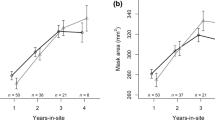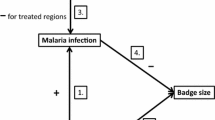Abstract
Hamilton and Zuk proposed that bright plumage in birds indicates genetic resistance to parasites, and that by selecting brighter males as mates, females can increase their offspring’s fitness due to this inherited resistance. The theory predicts a negative relationship between parasite load and plumage brightness in males. We used Sindbis virus clearance rate after an experimental infection to quantify parasite resistance in male greenfinches (Carduelis chloris) and related variation in clearance rate with variation in male plumage brightness. We found that certain aspects of brightness of the male plumage (i.e. tail-patch area) could be used to predict the virus infection clearance rate. Wing brightness was uninformative of virus clearance rate, but revealed age class. We found no clear relationship between antibody production rate and virus clearance rate or total viraemia. However, males with large tail patches tended to have a higher antibody production rate. The results suggest that the size of the male tail patch may function as an indicator of an individual male’s ability to resist parasite infections, thus supporting the Hamilton-Zuk theory for a novel taxon of parasites, a virus.
Similar content being viewed by others
Author information
Authors and Affiliations
Additional information
Received: 11 November 1999 / Received in revised form: 13 March 2000 / Accepted: 1 April 2000
Rights and permissions
About this article
Cite this article
Lindström, K., Lundström, J. Male greenfinches (Carduelis chloris) with brighter ornaments have higher virus infection clearance rate. Behav Ecol Sociobiol 48, 44–51 (2000). https://doi.org/10.1007/s002650000217
Issue Date:
DOI: https://doi.org/10.1007/s002650000217




